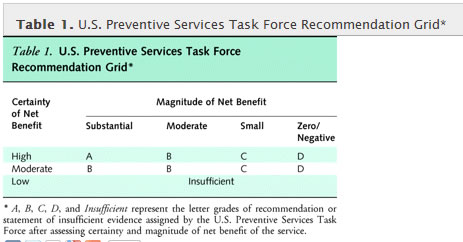
| Definitions of Success | Data Bases |
RESEARCH 101: I would go to the bottom and start at the bottom and work your way up (you get smarter at the bottom).
This is really intended for my use and is quite a mess – although I know where everything is.
Assessing Research Quality:
Links:
Good Start to understand how to rate research and how your research will be rated: Here
USPSTF: rating system. Here
 |
Guide-lines for the treatment of chronic spinal pain: here
STROBE: strengthening the reporting of observational studies in epidemiology.
The AHRQ quality assessment criteria for observational studies [here]:
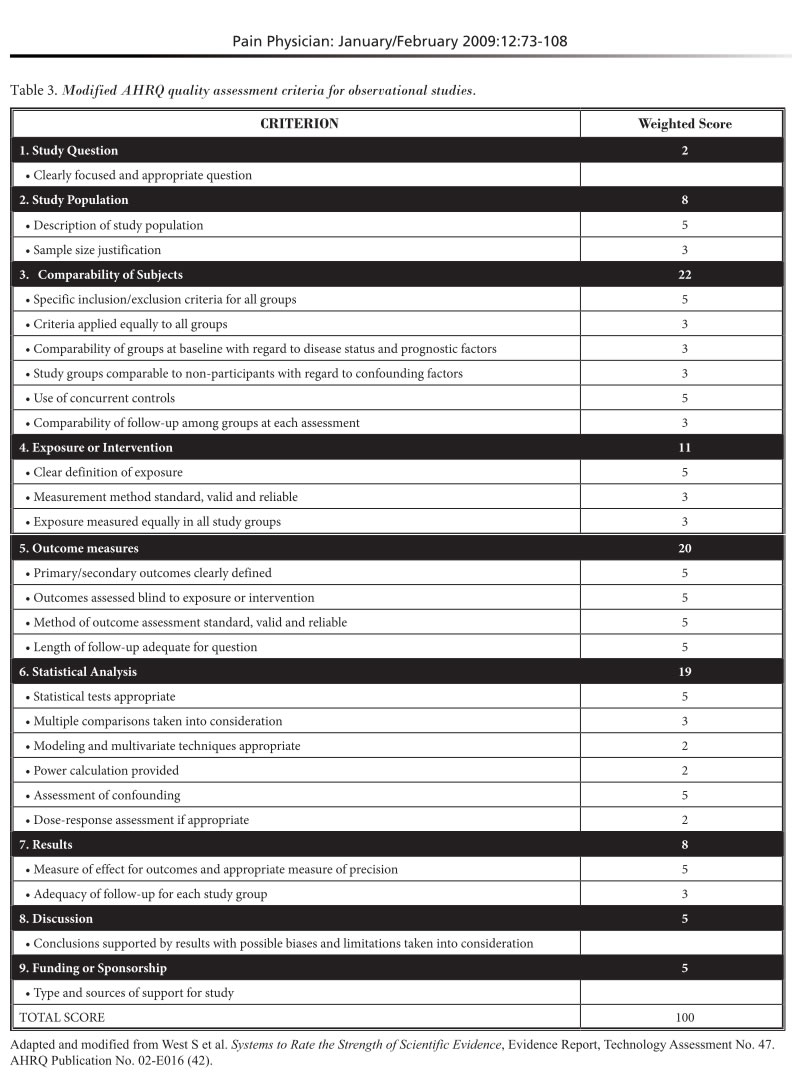 |
Less Frequently Used System which I'm pretty sure can be used for both observational studies, as well as randomized controlled trials.
Gerges et al (Harvard) used another standardized instrument (Downs et al) to assess methodological quality of studies called the Quality Index (22). The Quality Index is a 27-item, partially validated checklist that processes the reporting quality, external and internal validity, bias, confounding factors, and power of randomized and nonrandomized investigations. The authors found the Quality Index method useful for the comparison of observational and other nonrandomized studies, and has scores that range from 0 to 32. For observational studies, a quality score of 12 or greater is considered excellent (23). So the authors excluded all studies with the quality index score of less than 12 (24).
The authors noted that the methodological quality assessment tool of this investigation differed from other methodological quality assessment criteria utilized for other systematic reviews published in this journal. The authors stated the reason for this usage was "the application of different criteria will provide validity to the process rather than repeating the same criteria."
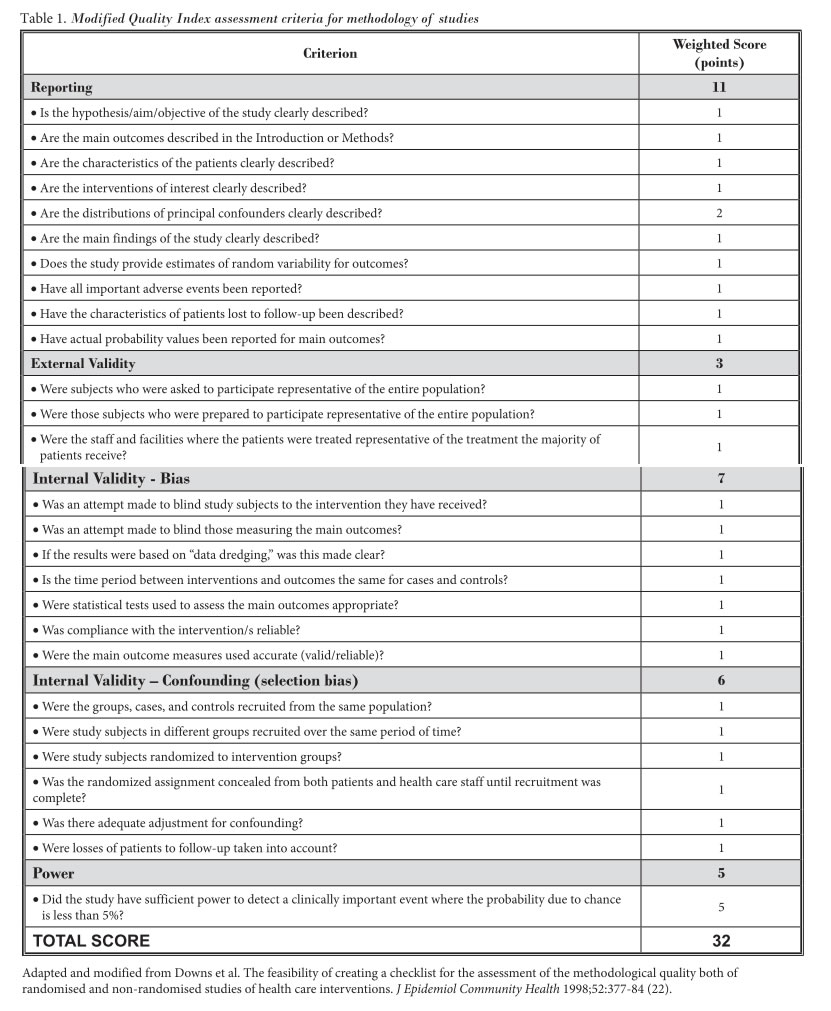 |
Outcome Reporting Vehicles Apparently Deemed Acceptable by the Harvard Nucleoplasty Meta-Analysis: (not sure why neck disability index is not here).
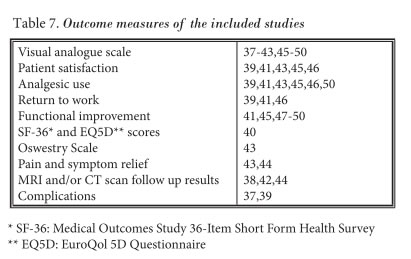 |
HOW TO REPORT AGE MEAN AND STD:
 |
STATISTICAL SOFTWARE:
SPSS for Windows (SPSS, Chicago, IL). (Nachemson likes).
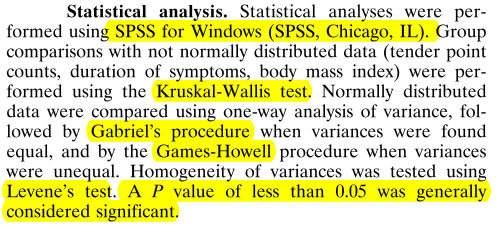
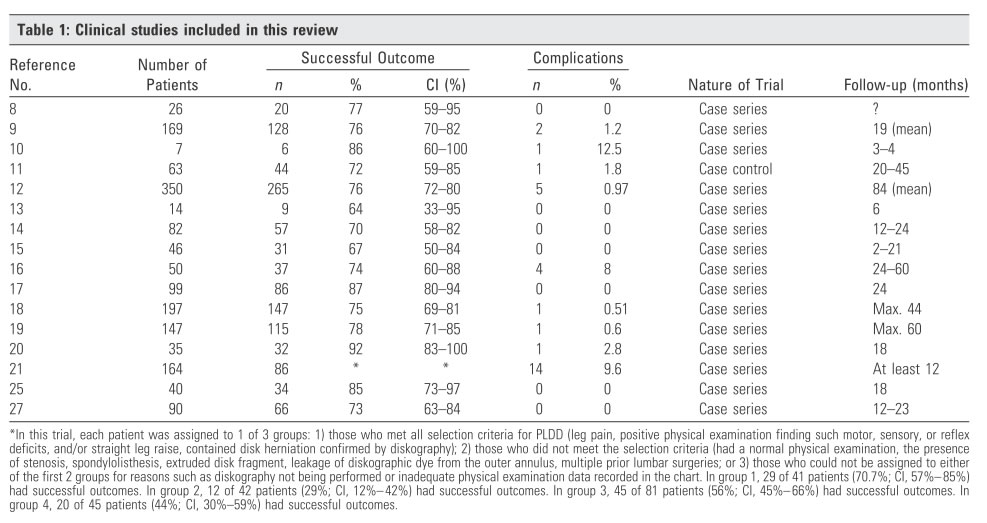 |
above are all the percutaneous laser disc decompression studyies.
PubMed
MEDLINE (Ovid Medline think is the same).
EMBASE
PEDrCINAHL
The Cochrane Library
The Database of Reviews of Effectiveness (DARE).
**Its hard to understand the difference between a meta-analysis and a systematic review.
HOW TO RATE STUDIES?
Heavy Hitters choice of methodological quality assessment (Manchikanti, Derby [standord], and Hirsch [Harvard]):
#1) For randomized controlled trials they use the Cochrane Review Criteria (34).
#2) the assessment of study quality for all of the observational studies was done according to the "Agency for Healthcare Research and Quality criteria" (AHRQ) (35).
#3)And for "consensus-based weighted scoring ( developed by The American Society of Interventional Pain Physicians (ASIPP) was utilized. The same scoring system has been used in multiple evaluations (12-14, 36-49).
Analysis of evidence: the Level of Evidence for support of a procedures efficacy, was determined based on the United States preventative service task force (USPSTF) criteria, which uses five levels of evidence (65): [this seems to be used to rate the efficacy of treatment interventions-- this seems to be the bottom line.] This is usually used on combination with Guyatt's for rating the efficacy of a treatment intervention--not sure why though.

Recommendations:
Recommendations of effectiveness (or efficacy) of an intervention was made according to Guyatt et al's criterial (66):
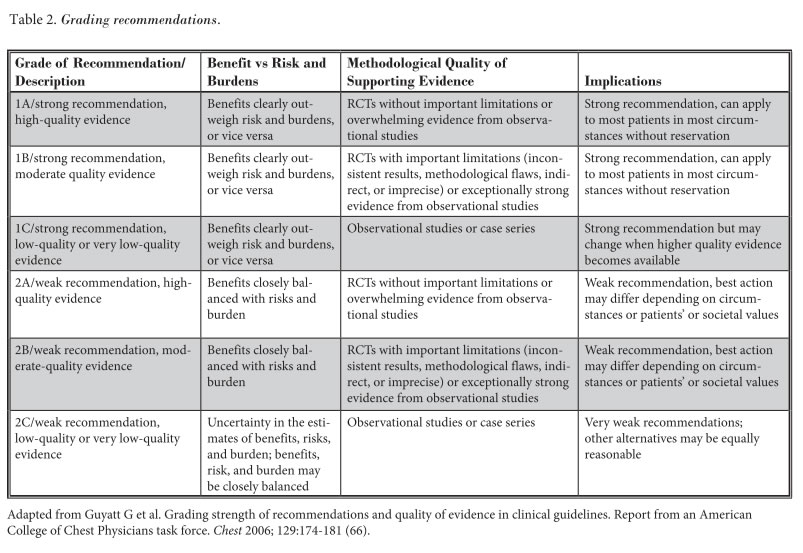
Real analysis: so it looks like AHRQ's tool was used for the methodological assessment of all the observational studies. Here's what it looks like: [here] THIS IS WHAT THEY WILL USE TO ASSESS YOUR PAPER!
Definitions of Treatment Success: (from Manchikanti – 2009 – systematic review of nucleoplasty).
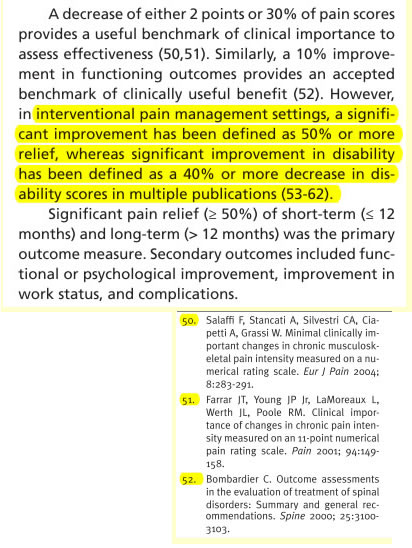 |
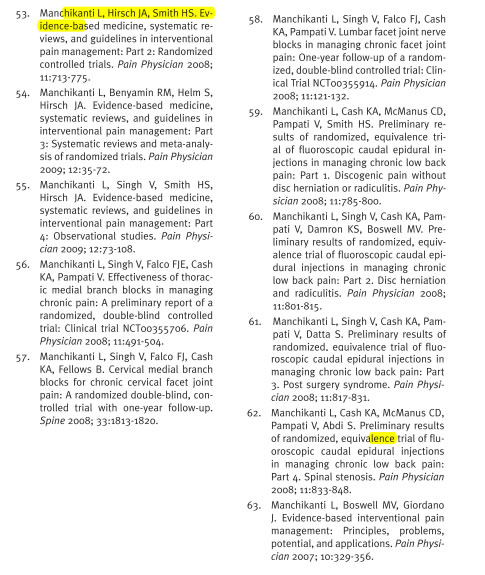 |
WHAT'S THE BUZZ:
So, Based upon Manchikanti, Derby, and Hirsch's paper on the efficacyouy of nucleoplasty, what's the language you would use to describe the evidence for the procedure?
ANSWER: you would say "the present evidence for nucleoplasty is Level II-3 with 2B/weak recommendation in managing radicular pain due to contained disc herniation."
ASSESSING THE QUALITY OF INDIVIDUAL RESEARCH PAPERS (AHRQ): 2-29-12:
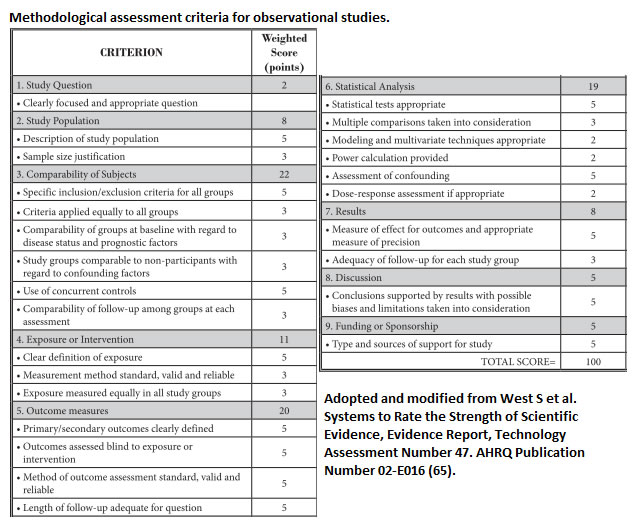 |
The initial collection of papers was cut down by applying the standard "Methodological Quality Assessment" described by the Agency of Healthcare Research and Quality (AHRQ) [35] for observational studies (see below). |
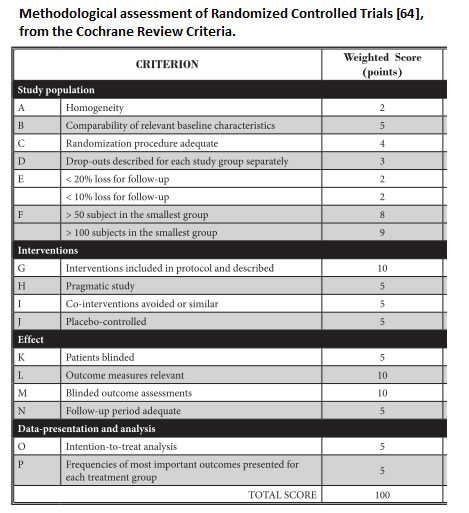 |
For the available Randomized Controlled Trials, methodological quality assessment was performed by utilizing the Cochrane review criteria. Need over 50 to be counted[34]. |
In order to qualify for this systematic review, research papers had to score at least 50/100 points.
In order to assess the final efficacy of APLD, pain relief was the primary outcome measure. Secondary outcome measures included functional improvement, improvement of psychological status, and return to work. More specifically, a higher standard of "success" was utilized in accord with opinions from multiple authors [86-95].
MEDICARE MEDICAID:
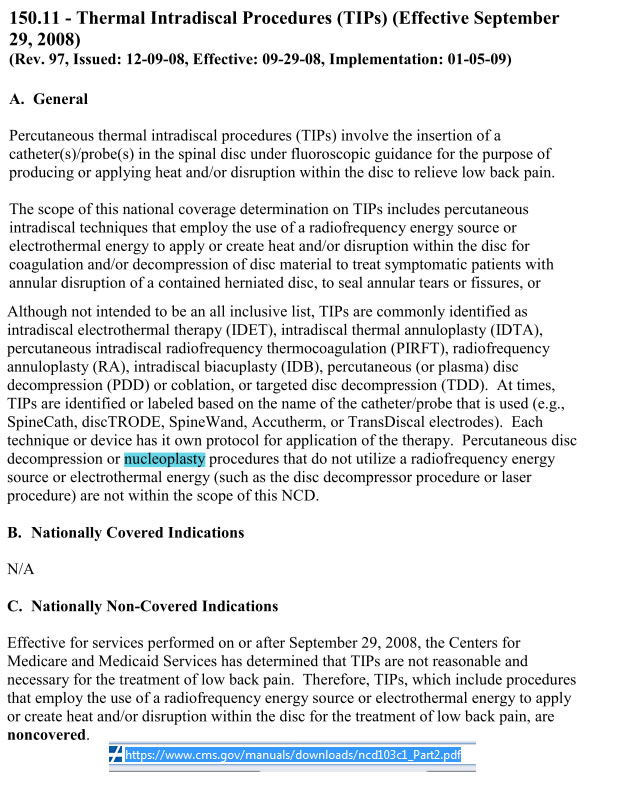 |
Investigational: nucleoplasty, automated percutaneous discectomy, laser discectomy, these are all considered investigational and are not covered by Blue Cross/Blue Shield as well is Medicare although I haven't researched it too much it seems obvious.
Retrospective Study:Some verbiage on how to handle a retrospectively created study:
| This study is limited in that it is a retrospective study and therefore is subjected to confounding factors. Additionally, not all eligible study patients were included in the study. Only 90% of patients who were determined to be eligible for this study were available for follow-up. The remaining 10% of patients either could not be contacted or refused to participate in the study. The results of this study are not necessarily reflective of this group of patients that were not included. Furthermore, because we studied the results of single-level TLIF performed with rhBMP-2, the results of this study cannot be generalized to patients who undergo multi-level TLIF procedures or who undergo a TLIF procedure in which a bone graft extender or substitute other than rhBMP-2 is used. Due to the retrospective nature of this study, there were not preoperative patient-reported clinical outcome measures available for comparison. CT scan data was limited in this study to patients who underwent CT scan postoperatively because of persistent back and/or leg pain. Future prospective studies would greatly benefit from postoperative CT scan data on all study patients, which may further our understanding of ectopic bone formation and the development of postoperative radiculitis following the use of rhBMP-2 in this “off label” use. |
OTHER CAUSES OF PAIN:
In addition, the expression of symptoms may be clouded by sociological factors and personal psychodynamics [42] [Greenough CG, Fraser RD. the effects of compensation on recovery from low back injury." Spine 1989; 14:947-55.] in free article USA TLIF versus TLIF. |
|
Patient demographics for spine studies:
 |
Ohtori S, Suzuki M, Koshi T et al. “Single Level Instrumented Posterolateral Fusion of the Lumbar Spine with a Local Bone Graft versus And Iliac Crest Bone Graft a prospective, randomized study with two-year follow-up." Eur Spine J (2011) 20:635-639. |
PATIENT SATISFACTION QUESTIONS: (FROM Haid et al)
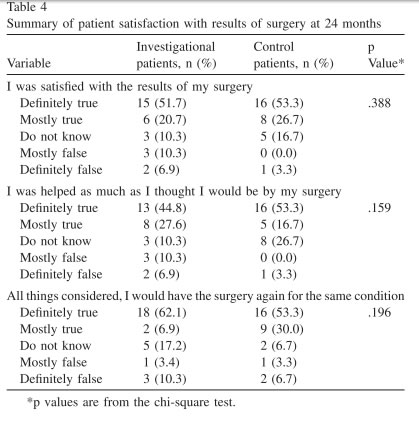 |
References:
12) Hirsch JA, Singh V, Manchikanti L, et al. "Automated Percutaneous Lumbar Discectomy for the contained herniated lumbar disc: A Systematic Assessment of Evidence." Pain Physician 2009; 12:601-620.
13) Singh V, Manchikanti L, Helm S, Hirsch JA, et al. "percutaneous lumbar laser disk decompression: a systematic review of current evidence." Pain physician 2009; 12:573-588.
14) Singh V, Falco FJE, Helm S, Manchikanti L: systematic review of percutaneous lumbar mechanical disc decompression utilizing Dekompressor." Pain physician 2009; 12:589-599.
34) Koes BW et al. "Efficacy of epidural steroid injections for low back pain and sciatica: a systematic review of randomized clinical trials." Pain 1995; 63-279-288.
35) West S, et al. "Systems to rate the strength of scientific evidence, evidence report, technology assessment number 47." AHRQ Publication No. 02E016. Rockville, MD: Agency for Healthcare Research and Quality, 2002. www.thecre.com/pdf/ahrq-system-strength.pdf
65) Berg AO, Allan JD. "Introducing the Third US Preventative Services Task Force." Am J Prev Med 2001; 20:s3--S4.
66) Guyatt G, et al. "Grading Strength of Recommendations and Quality of EvidenceAnd Clinicalguidelines. Report from an American College of Chest Physicians Task Force." chest 2006; 129: 174-181.
86) Manchikanti L, Hirsch JA, Smith HS. “Evidence-based medicine, systematic reviews, and guidelines in interventional pain management: Part 2: randomized controlled trials.” Pain physician 2008; 11:713-775.
87) Manchikanti L, et al. “evidence-based medicine, systematic reviews, and guidelines in interventional pain management: part three: systematic reviews and meta-analysis of randomized controlled trials." Pain physician 2009; 12:35-72.
88) Manchikanti L, Singh V, et al. “evidence-based medicine, systematic reviews, and guidelines in interventional pain management: part four: observational studies. Pain physician 2009; 12:73 – 108.
89) Manchikanti L, Singh V, et al. “effectiveness of thoracic medial branch blocks in managing chronic pain: a preliminary report of randomized, double-blind controlled trial:NCT00355706. Pain physician 2008; 11:491-504.
90) Manchikanti L, Singh V, et al. “cervical medial branch blocks for chronic cervical facet joint pain: a randomized double-blind controlled trial with one-year follow-up." Spine 2008; 33:1813 – 1820.
91) Manchikanti L, et al. “lumbar facet joint nerve blocks in managing chronic facet joint pain: one-year follow-up of randomized double-blind controlled trial: clinical trial NCT 00355914.” Pain physician 2008; 11:121-132.
92) Manchikanti L, Cash KA, et al. "preliminary results of randomized, equivalent trial of fluoroscopic caudal epidural injections in managing chronic low back pain: part one. Discogenic pain without disc herniation or radiculitis.” Pain physician 2008; 11:785-800.
93) Manchikanti L, Singh V, et al. “preliminary results of randomized, equivalents trial of fluoroscopic caudal epidural injections in managing chronic low back pain; part two. Disc herniation and radiculitis." Pain physician 2008; 11:801-815.
94) Manchikanti L, Singh V, Cash KA, et al. "preliminary results of randomized, equivalents trial of fluoroscopic caudal epidural injections in managing chronic low back pain: part three. Postsurgical syndrome. Pain physician 2008; 11:817-831.
95) Manchikanti L, et al. “preliminary results of randomized, equivalence trial of fluoroscopic caudal epidural injections in managing chronic low back pain: part four. Spinal stenosis. Pain physician 2008; 11:833-848.